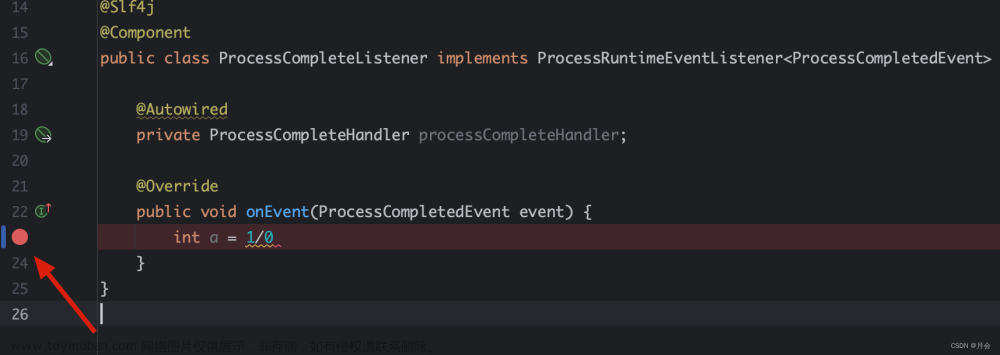spring事件监听机制离不开容器IOC特性提供的支持,比如容器会自动创建事件发布器,自动识别用户注册的监听器并进行管理,在特定的事件发布后会找到对应的事件监听器并对其监听方法进行回调。Spring帮助用户屏蔽了关于事件监听机制背后的很多细节,使用户可以专注于业务层面进行自定义事件开发。然而我们对内部的实现还是有一些疑问,比如:
• 事件发布器ApplicationEventMulticaster是何时被初始化的,初始化过程中都做了什么?
• 注册事件监听器的过程是怎样的,容器怎么识别出它们并进行管理?
• 容器发布事件的流程是怎样的?它如何根据发布的事件找到对应的事件监听器,事件和由该事件触发的监听器之间的匹配规则是怎样的?
初始化事件发布器流程
真正的事件发布器是ApplicationEventMulticaster,它定义在AbstractApplicationContext中,并在ApplicationContext容器启动的时候进行初始化。在容器启动的refrsh()方法中可以找到初始化事件发布器的入口方法,如下图所示:
/**
* Initialize the ApplicationEventMulticaster.
* Uses SimpleApplicationEventMulticaster if none defined in the context.
* @see org.springframework.context.event.SimpleApplicationEventMulticaster
*/
protected void initApplicationEventMulticaster() {
ConfigurableListableBeanFactory beanFactory = getBeanFactory();
if (beanFactory.containsLocalBean(APPLICATION_EVENT_MULTICASTER_BEAN_NAME)) {
this.applicationEventMulticaster =
beanFactory.getBean(APPLICATION_EVENT_MULTICASTER_BEAN_NAME, ApplicationEventMulticaster.class);
if (logger.isTraceEnabled()) {
logger.trace("Using ApplicationEventMulticaster [" + this.applicationEventMulticaster + "]");
}
}
else {
this.applicationEventMulticaster = new SimpleApplicationEventMulticaster(beanFactory);
beanFactory.registerSingleton(APPLICATION_EVENT_MULTICASTER_BEAN_NAME, this.applicationEventMulticaster);
if (logger.isTraceEnabled()) {
logger.trace("No '" + APPLICATION_EVENT_MULTICASTER_BEAN_NAME + "' bean, using " +
"[" + this.applicationEventMulticaster.getClass().getSimpleName() + "]");
}
}
}
这里会根据核心容器beanFactory中是否有id为applicationEventMulticaster的bean分两种情况:
(1)容器中已有id为applicationEventMulticaster的bean:直接从容器缓存获取或是创建该bean实例,并交由成员变量applicationEventMulticaster保存。当用户自定义了事件发布器并向容器注册时会执行该流程。
(2)容器中不存在applicationEventMulticaster的bean:这是容器默认的执行流程,会创建一个SimpleApplicationEventMulticaster,其仅在实现事件发布器基本功能(管理事件监听器以及发布容器事件)的前提下,增加了可以设置任务执行器Executor和错误处理器ErrorHandler的功能,当设置Executor为线程池时,则会以异步的方式对事件监听器进行回调,而ErrorHandler允许我们在回调方法执行错误时进行自定义处理。默认情况下,这两个变量都为null。

之后会调用beanFactory.registerSingleton方法将创建的SimpleApplicationEventMulticaster实例注册为容器的单实例bean。
初始化事件发布器总结一句话:由容器实例化用户自定义的事件发布器或者由容器帮我们创建一个简单的事件发布器并交由容器管理。
注册事件监听器流程
注册事件监听器的流程在初始化事件发布器之后,如下图所示:

/**
* Add beans that implement ApplicationListener as listeners.
* Doesn't affect other listeners, which can be added without being beans.
*/
protected void registerListeners() {
// 首先注册静态指定的监听器。
for (ApplicationListener<?> listener : getApplicationListeners()) {
getApplicationEventMulticaster().addApplicationListener(listener);
}
// 不要在这里初始化FactoryBeans:我们需要保留所有常规Bean
// 未初始化以允许后处理器应用于它们!
String[] listenerBeanNames = getBeanNamesForType(ApplicationListener.class, true, false);
for (String listenerBeanName : listenerBeanNames) {
getApplicationEventMulticaster().addApplicationListenerBean(listenerBeanName);
}
// 发布早期应用程序事件
Set<ApplicationEvent> earlyEventsToProcess = this.earlyApplicationEvents;
this.earlyApplicationEvents = null;
if (earlyEventsToProcess != null) {
for (ApplicationEvent earlyEvent : earlyEventsToProcess) {
getApplicationEventMulticaster().multicastEvent(earlyEvent);
}
}
}
容器事件发布流程
org.springframework.context.support.AbstractApplicationContext#publishEvent(java.lang.Object, ResolvableType)
将给定事件发布给所有侦听器
前面说,在启动的时候如果没有一个beanName叫做applicationEventMulticaster的ApplicationEventMulticaster,那使用的就是SimpleApplicationEventMulticaster,该组件会在容器启动时被自动创建,并以单例的形式存在,管理了所有的事件监听器,并提供针对所有容器内事件的发布功能。
org.springframework.context.event.SimpleApplicationEventMulticaster#multicastEvent(ApplicationEvent, ResolvableType)
@Override
public void multicastEvent(final ApplicationEvent event, @Nullable ResolvableType eventType) {
//获取事件类型
ResolvableType type = (eventType != null ? eventType : resolveDefaultEventType(event));
//获取事件发布器内的任务执行器,默认该方法返回null
Executor executor = getTaskExecutor();
//遍历所有和事件匹配的事件监听器
for (ApplicationListener<?> listener : getApplicationListeners(event, type)) {
if (executor != null) {
//异步回调监听方法
executor.execute(() -> invokeListener(listener, event));
} else {
//同步回调监听方法
invokeListener(listener, event);
}
}
}
如何根据事件类型找到匹配的所有事件监听器?
org.springframework.context.event.AbstractApplicationEventMulticaster#getApplicationListeners(ApplicationEvent, ResolvableType)
/**
* Return a Collection of ApplicationListeners matching the given
* event type. Non-matching listeners get excluded early.
* @param event the event to be propagated. Allows for excluding
* non-matching listeners early, based on cached matching information.
* @param eventType the event type
* @return a Collection of ApplicationListeners
* @see org.springframework.context.ApplicationListener
*/
protected Collection<ApplicationListener<?>> getApplicationListeners(
ApplicationEvent event, ResolvableType eventType) {
// 获取事件中的事件源对象
Object source = event.getSource();
// 获取事件源类型
Class<?> sourceType = (source != null ? source.getClass() : null);
// 以事件类型和事件源类型为参数构建一个cacheKey ,用于从缓存map中获取与之匹配的监听器列表
ListenerCacheKey cacheKey = new ListenerCacheKey(eventType, sourceType);
// 根据cacheKey从缓存中获取CachedListenerRetriever
ListenerRetriever retriever = this.retrieverCache.get(cacheKey);
if (retriever != null) {
return retriever.getApplicationListeners();
}
if (this.beanClassLoader == null ||
(ClassUtils.isCacheSafe(event.getClass(), this.beanClassLoader) &&
(sourceType == null || ClassUtils.isCacheSafe(sourceType, this.beanClassLoader)))) {
// Fully synchronized building and caching of a ListenerRetriever
synchronized (this.retrievalMutex) {
retriever = this.retrieverCache.get(cacheKey);
if (retriever != null) {
return retriever.getApplicationListeners();
}
retriever = new ListenerRetriever(true);
// 不存在就检索给定事件和源类型的应用程序侦听器,并放到缓存
Collection<ApplicationListener<?>> listeners =
retrieveApplicationListeners(eventType, sourceType, retriever);
this.retrieverCache.put(cacheKey, retriever);
return listeners;
}
}
else {
// No ListenerRetriever caching -> no synchronization necessary
return retrieveApplicationListeners(eventType, sourceType, null);
}
}
如果事件时第一次发布,会遍历所有的事件监听器,并根据事件类型和事件源类型进行匹配:
org.springframework.context.event.AbstractApplicationEventMulticaster#retrieveApplicationListeners文章来源:https://www.toymoban.com/news/detail-659464.html
/**
* Actually retrieve the application listeners for the given event and source type.
* @param eventType the event type
* @param sourceType the event source type
* @param retriever the ListenerRetriever, if supposed to populate one (for caching purposes)
* @return the pre-filtered list of application listeners for the given event and source type
*/
private Collection<ApplicationListener<?>> retrieveApplicationListeners(
ResolvableType eventType, @Nullable Class<?> sourceType, @Nullable ListenerRetriever retriever) {
// 存放监听器的列表
List<ApplicationListener<?>> allListeners = new ArrayList<>();
Set<ApplicationListener<?>> listeners;
Set<String> listenerBeans;
synchronized (this.retrievalMutex) {
listeners = new LinkedHashSet<>(this.defaultRetriever.applicationListeners);
listenerBeans = new LinkedHashSet<>(this.defaultRetriever.applicationListenerBeans);
}
// 添加以编程方式注册的侦听器,
// 包括来自ApplicationListenerDetector的侦听器(单例bean和内部bean)。
for (ApplicationListener<?> listener : listeners) {
if (supportsEvent(listener, eventType, sourceType)) {
if (retriever != null) {
retriever.applicationListeners.add(listener);
}
allListeners.add(listener);
}
}
// 按bean名称添加侦听器,这可能与上面通过编程注册的侦听器重叠,
// 但这里可能有额外的元数据。
if (!listenerBeans.isEmpty()) {
ConfigurableBeanFactory beanFactory = getBeanFactory();
for (String listenerBeanName : listenerBeans) {
try {
if (supportsEvent(beanFactory, listenerBeanName, eventType)) {
ApplicationListener<?> listener =
beanFactory.getBean(listenerBeanName, ApplicationListener.class);
if (!allListeners.contains(listener) && supportsEvent(listener, eventType, sourceType)) {
if (retriever != null) {
if (beanFactory.isSingleton(listenerBeanName)) {
retriever.applicationListeners.add(listener);
}
else {
retriever.applicationListenerBeans.add(listenerBeanName);
}
}
allListeners.add(listener);
}
}
else {
// 删除最初来自ApplicationListenerDetector的不匹配侦听器,
// 可能会被上面额外的BeanDefinition元数据(例如工厂方法泛型)排除。
Object listener = beanFactory.getSingleton(listenerBeanName);
if (retriever != null) {
retriever.applicationListeners.remove(listener);
}
allListeners.remove(listener);
}
}
catch (NoSuchBeanDefinitionException ex) {
// 单一侦听器实例(没有支持bean定义)消失-可能在销毁阶段中期}
}
}
//对匹配的监听器列表进行排序
AnnotationAwareOrderComparator.sort(allListeners);
if (retriever != null && retriever.applicationListenerBeans.isEmpty()) {
retriever.applicationListeners.clear();
retriever.applicationListeners.addAll(allListeners);
}
return allListeners;
}
容器事件发布的整个流程,可以总结如下: 文章来源地址https://www.toymoban.com/news/detail-659464.html
文章来源地址https://www.toymoban.com/news/detail-659464.html
到了这里,关于Spring事件监听源码解析的文章就介绍完了。如果您还想了解更多内容,请在右上角搜索TOY模板网以前的文章或继续浏览下面的相关文章,希望大家以后多多支持TOY模板网!












